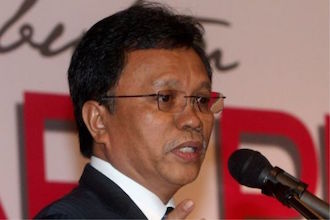How far can Shafie go?

Arnold Puyok, Malay Mail Online
Shafie Apdal, who withdrew from Umno recently is trying hard to revive his political career. It must have been tough for him, now that his political career is hanging in the balance.
There has been a lot of talks lately about Shafie’s next move. Will he form a new party and align himself closely with local-based opposition parties? Can Shafie make a difference during these trying times in Malaysian politics especially Sabah?
Like Sabah PKR chief Lajim Ukin whose support is confined within his Bisaya stronghold in Beaufort, Shafie’s base support is mainly concentrated in the East Coast and Semporna proper.
During his heyday as federal minister, Shafie spent most of time juggling between his ministerial and party duties at the federal level. Through a combination of strong family ties and patronage protection, Shafie cultivated an almost unbreakable relationships with the Bajau and Suluk electorates in the East Coast.
Outside the East Coast, however, Shafie is persona non grata. Unlike other Umno leaders such as Musa Aman, Salleh Said and Masidi Manjun, Shafie has no affinity with the Kadazandusun generally. This is one of Shafie’s main weaknesses.
Securing the support of the Kadazandusun in particular is important as they collectively represent roughly between 30-40 per cent of Sabah’s total population. Shafie’s close association with the KDM (Kadazandusun) Malaysia is seen as his attempt to win the support of the Kadazandusun.
But the Kadazandusun mainly see KDM Malaysia as an outfit to weaken the Kadazandusun support to KDCA (Kadazandusun Cultural Association) and the PBS (Parti Bersatu Sabah). Without a clear vision and credible leadership, the future of KDM Malaysia remains uncertain.
Most Kadazandusun are with the KDCA and USDA (United Sabah Dusun Association) — two of the oldest and more popular Kadazandusun-based associations.
The latest addition is the MNC (Momogun National Congress) that is gaining popularity for its pragmatic socio-ecomic empowerment programmes. Without strong Kadazandusun support base, it will be difficult for Shafie to widen his grassroots support outside the East Coast
Shafie’s next challenge is to form an alliance with local-based opposition parties. This will not be easy as Shafie is long known for his pro-federal policies. Shafie’s sudden U-turn could backfire as many see it as his attempt to revive his fading popularity.
The questions are: What difference can Shafie make? Will he propose different if not more innovative policy prescriptions for a better Sabah? Or, will he simply promote the “Sabah for Sabahans” battlecry without offering anything constructive in return for Sabahans?
With the clock ticking, Shafie is racing against time to make his next move. It is possible for Shafie to form his own party or take over any of the existing parties in Sabah.
Recruiting new members and making the new party relevant to Sabahans will be Shafie’s main challenge. If Shafie succeeds in forming an alliance with local-based opposition parties, what policy platform would the alliance promote and who would lead it?
Whether he likes it or not, Shafie, the new “Sabah champion”, will have to join the other local champions long known for their anti-federal and strong regional outlook. While many in Sabah have welcomed Shafie’s return to state politics, others have this to say to him: “All the best gaman.”

